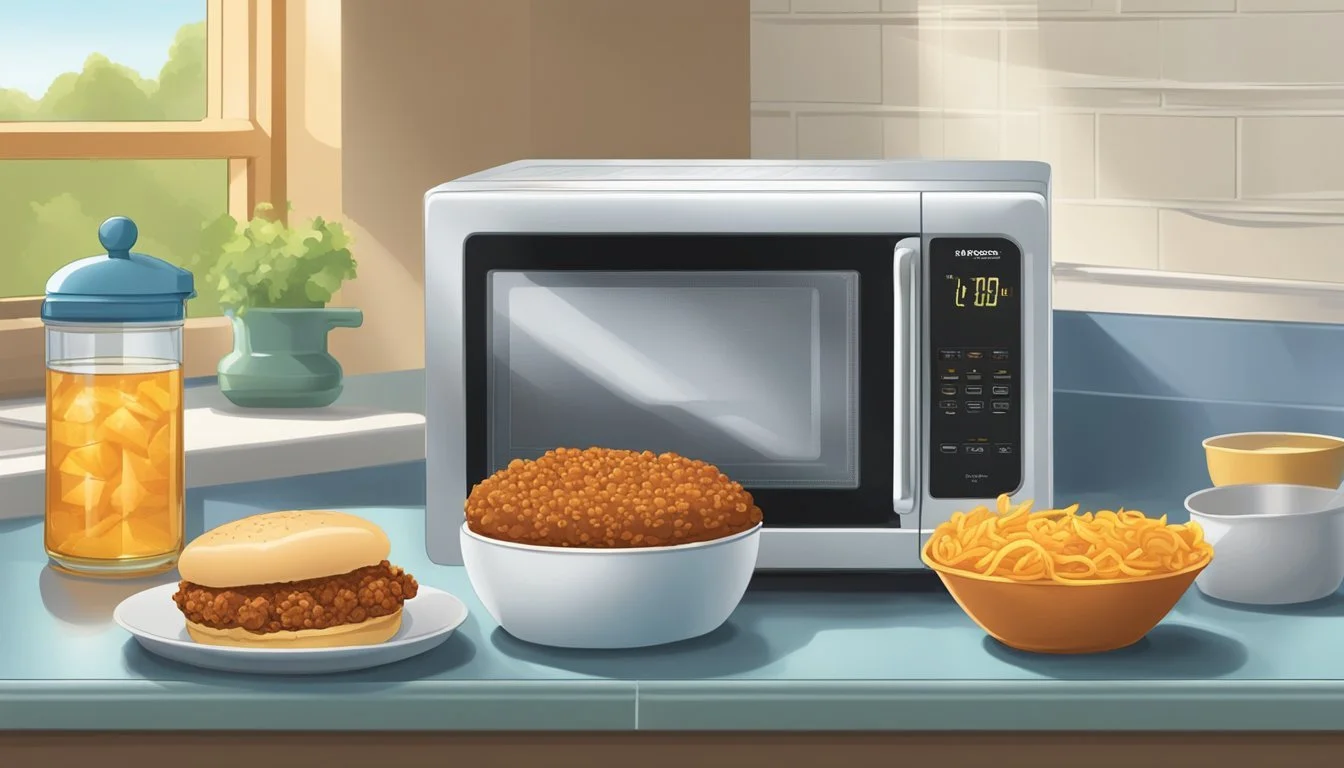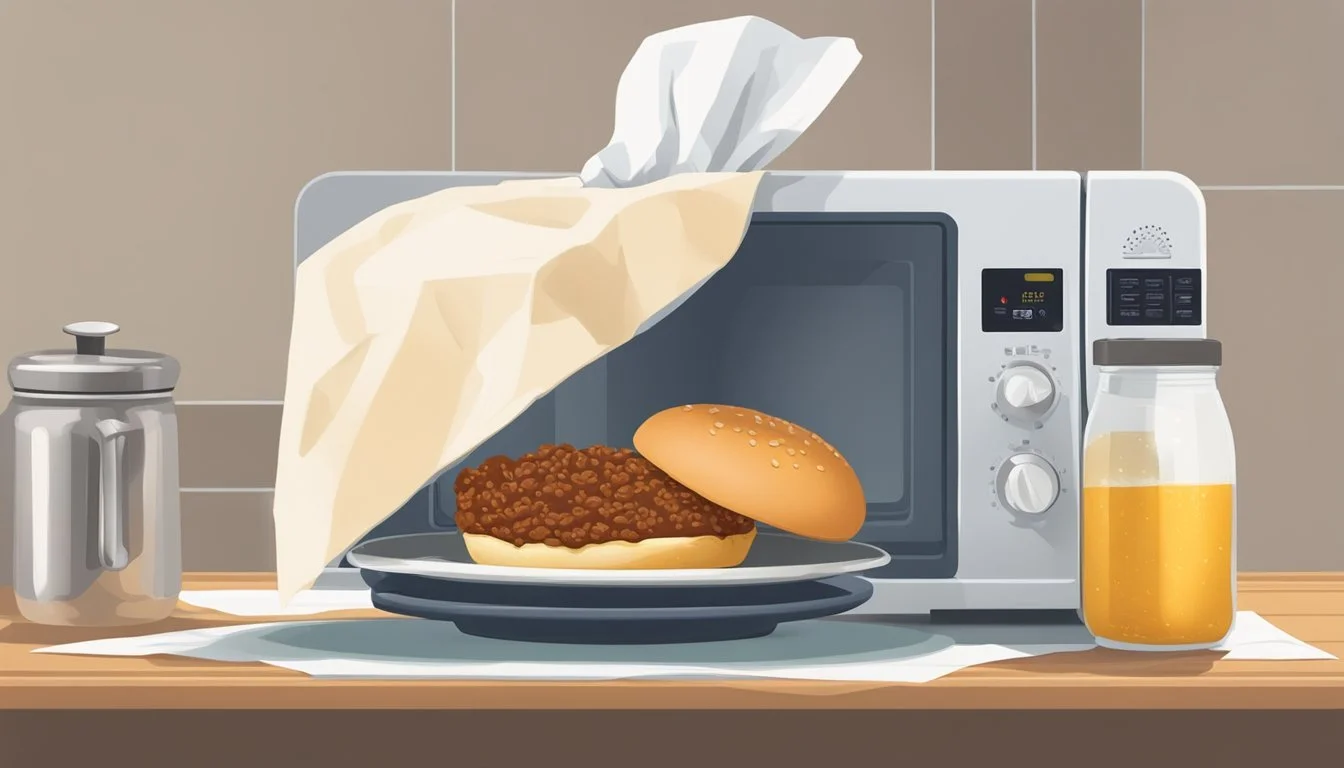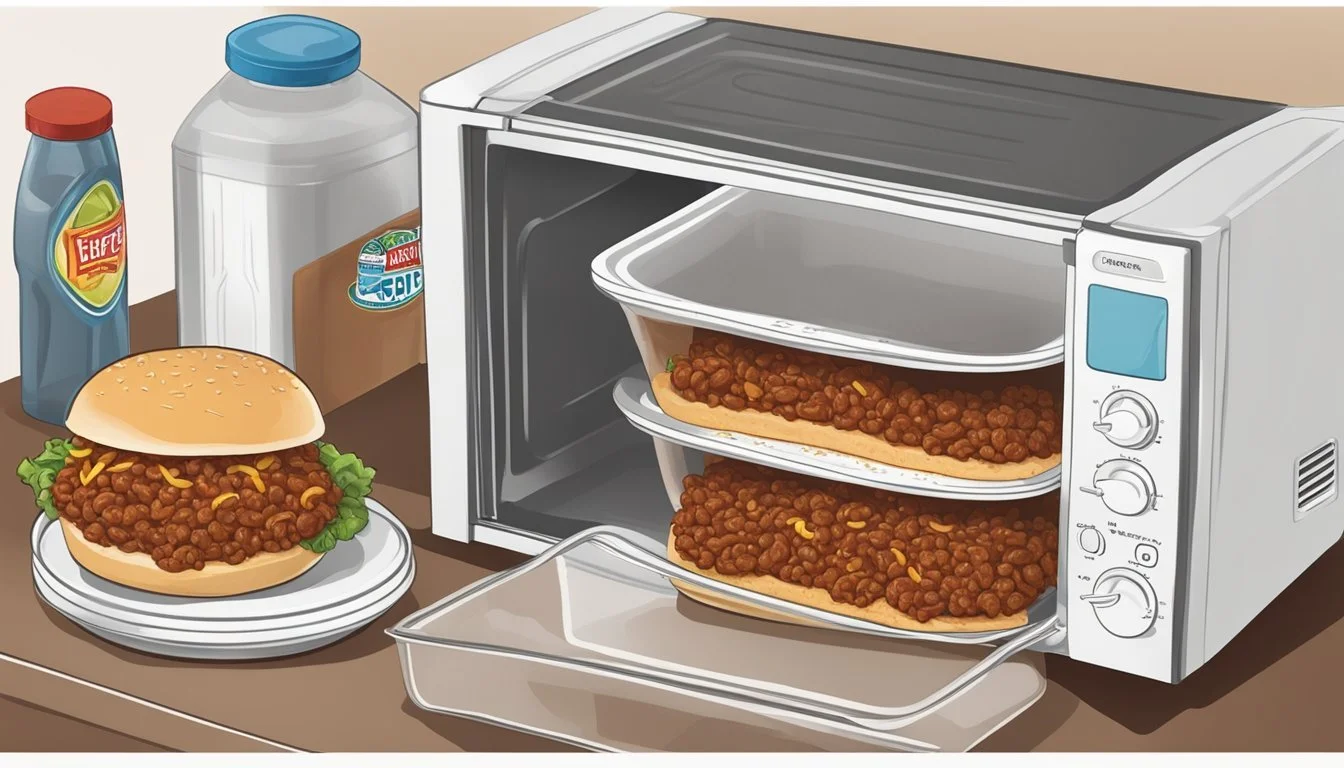Best Way to Reheat a Sloppy Joe
Keeping the Bun Crisp & Delicious
Reheating a Sloppy Joe while maintaining the integrity of the bun is a matter that requires specific attention to detail. The key lies in separating the components to address their individual reheating needs. The Sloppy Joe filling, generally a mixture of ground beef, onions, (What wine goes well with onions?) and a tomato-based sauce, can retain its quality through a gentle reheating process. By using a skillet over medium-low heat, the mixture can be stirred occasionally until it reaches the ideal temperature, which not only warms it thoroughly but also preserves its moist texture.
On the other hand, the buns demand a different approach to avoid sogginess. Toasting buns enhances their texture and creates a barrier that mitigates the risk of them turning soggy when the warm mixture is added. To achieve the best results, the buns can be heated in a toaster or an oven until they are crisp and warm. This guarantees that when the Sloppy Joe mixture is spooned onto the bun, the bread remains firm and adds a pleasing contrast to the savory filling. By treating the meat and the buns separately, one achieves a Sloppy Joe that is as enjoyable as when it was first made.
Understanding the Sloppy Joe
Sloppy Joes are a quintessential American comfort food, consisting of a tangy and sweet ground beef filling served on hamburger buns. The classic Sloppy Joe sauce combines tomatoes, onions, and peppers with condiments and seasonings such as mustard, ketchup, Worcestershire sauce, and brown sugar. This mixture creates a hearty blend that is both rich in flavor and easy to assemble.
Key Ingredients:
Ground Beef: The foundation of the filling.
Tomatoes: Adds acidity and moisture.
Onions and Peppers: Provide sweetness and a slight crunch.
Mustard & Ketchup: Balance sweetness with tanginess.
Worcestershire Sauce: Imparts a savory depth.
Brown Sugar: Offers a hint of molasses and sweetness.
Salt & Pepper: Basic seasonings for taste.
A standard sloppy joe recipe involves browning the ground beef, then sautéing the onions and peppers before combining all the sauce ingredients and allowing the mixture to simmer. The result is a thick, savory filling commonly associated with informal gatherings and easy weeknight dinners.
Beyond the traditional sandwich, Sloppy Joe fillings can be served as sliders, making them ideal for parties or as appetizers. As with any recipe, homemade sloppy joes can be customized. Some may opt for a spicier version or a variation with less sugar. Common sides include onion rings, corn on the cob, or a simple salad to balance the richness of the dish.
The challenge in reheating a Sloppy Joe especially when excluding the bun is to maintain the integrity of the sauce's texture while ensuring it is heated evenly through. Proper reheating techniques can ensure that the filling's optimal taste and consistency are preserved, ready to be enjoyed anew.
Preparation Before Reheating
Before reheating a Sloppy Joe, separating the sandwich components is crucial to prevent the buns from becoming soggy. The protein and tomato sauce mixture, which contains both fiber and fat, should be stored separately from the hamburger buns to maintain the texture and quality of the leftovers.
Storage of Sloppy Joe Mixture:
Ensure the leftover Sloppy Joe mixture is cooled to room temperature.
Transfer it to an airtight container. This minimizes the exposure to air, preserving the flavors and preventing spoilage.
Bun Storage:
Once cool, wrap the hamburger buns individually in plastic wrap.
For storage beyond a couple of days, one might consider freezing the buns. To freeze, wrap them in aluminum foil or place them in a freezer bag.
Table for Effective Freezing and Thawing:
Action Instructions To Freeze Wrap buns individually; place in freezer-safe bag. To Thaw Place in refrigerator overnight or on counter.
Prep Time Before Reheating:
Remove the Sloppy Joe mixture from the refrigerator, allowing it to reach room temperature, which can reduce reheating time.
If the hamburger buns were frozen, they should be thawed thoroughly at room temperature or gently in the microwave to preserve their texture.
By following these steps, one can ensure their Sloppy Joe will be almost as good as when it was freshly made, with a protein-packed filling that's hot and savory and buns that are warm but not soggy.
Reheating Techniques
When reheating sloppy joe filling and buns, it's essential to use methods that maintain the texture: keeping the filling moist and the buns crisp. Several techniques can accomplish this while preventing sogginess.
Using the Oven
They can reheat sloppy joe filling in the oven to preserve moisture without compromising the buns' crispiness. By toasting the buns separately on a baking sheet, they achieve an ideal texture. They should wrap the filling in aluminum foil and place it in a preheated oven at a moderate temperature, around 350°F, for about 10-15 minutes.
Steps:
Preheat oven to 350°F.
Wrap filling in aluminum foil.
Bake filling for 10-15 minutes.
Toast buns separately on a baking sheet until crisp.
Trying the Microwave
They can utilize the microwave for a quick and easy reheating method, although this may not prevent sogginess as effectively. They should transfer the filling to a microwave-safe container, cover it with a damp paper towel to retain moisture, and heat in short intervals, stirring between each. For the buns, microwaving is not recommended as it tends to make them soft rather than crisp.
Microwave Steps:
Cover filling with damp paper towel.
Heat in short bursts, stirring between.
Skillet Reheating
They can reheat the filling in a skillet on medium heat, which allows them to add a bit of fat to enhance flavor and avoid drying out. They should continually stir for even heat distribution. For the buns, toasting them in the skillet can add crispiness.
Skillet Method:
Heat filling in skillet with a little fat.
Toast buns separately in the skillet for crisp edges.
Air Fryer Option
An air fryer offers a quick solution with less oil that can achieve crispiness for both the filling and buns in short cook time. They should place the filling in the air fryer basket, set at a low temperature, and monitor closely to avoid drying out. They can air fry the buns for a couple of minutes to toast them slightly.
Air Fryer Instructions:
Set air fryer to a low temperature.
Place filling in basket, cook briefly.
Toast buns separately for added crispness.
Serving and Presentation
When serving a reheated Sloppy Joe, focusing on the texture of the bun and the warmth of the filling is key to an enjoyable meal. Toasting the buns separately ensures they retain their crispness. For perfect toasting, one might opt for a broiler or toaster oven, monitoring closely to achieve a light golden color. Whether one chooses a dinner roll, brioche bun, or a classic hamburger bun, this step is crucial to prevent sogginess from the filling’s moisture.
In terms of presentation, a neatly toasted bun serves as the perfect vessel for the savory Sloppy Joe filling. Arrange the buns on a serving platter, open-faced, and spoon the reheated filling generously onto the bottom half of each bun. It's advisable to prepare portions that are adequate for the crowd at the table, ensuring that every guest gets a satisfying serving.
For those seeking a low-carb alternative, lettuce wraps can be a refreshing substitute for buns. They add a crunchy texture and a vibrant color, enhancing the dish’s visual appeal. Condiments such as pickles, onions, or cheese can be served on the side, allowing guests to customize their Sloppy Joes to their taste preferences.
If serving at parties or for family dinners, one might consider a self-serve station where guests can build their own Sloppy Joes. This adds an interactive element to the dining experience and caters to individual preferences. Ensure that the filling remains warm to maintain its flavor and texture.
For smaller buns, such as hot dog buns or mini dinner rolls, servings should be adjusted accordingly. These buns are excellent for kid-friendly meals or as bite-sized options for a larger party spread.
Remember, when it comes to Sloppy Joes, it's not just about the recipe but also how it's served that makes the meal memorable.
Complementary Sides
When crafting the perfect meal with a sloppy joe, selecting the right side dishes not only complements the flavors but also balances the meal. Side options range from classic picks to more creative pairings that can cater to a variety of palates.
1. French Fries: A classic companion to any sandwich, french fries offer a crisp contrast to the soft texture of a bun-less sloppy joe. They can be seasoned, loaded, or served plain for a satisfying crunch.
2. Coleslaw: For a fresh and tangy counterpart, coleslaw is a prime choice. Its creamy dressing and crunchy cabbage blend harmoniously with the rich and hearty sloppy joe filling.
3. Onion Rings: Similar to french fries, onion rings bring a delightful crispness and a hint of sweetness that pairs well with the savory flavors of the sloppy joe.
Sliced Vegetables: A plate of fresh-sliced vegetables like carrots, celery, and bell peppers provides a nutritious and colorful side that offsets the indulgence of the main dish.
Chopped Onions and Pickles: For those who favor a sharper taste, chopped onions add zest, while pickles introduce a vinegary pop to awaken the taste buds.
In summary, when serving a bun-less sloppy joe, these sides ensure a well-rounded and enjoyable dining experience. One can choose to stick to the classics or mix in some healthier options, depending on their preference and the occasion.
Storing Leftovers
Storing leftover Sloppy Joe meat properly is essential to maintain its quality and flavor. Ideally, the meat and buns should be stored separately to prevent the bread from absorbing excess moisture and becoming soggy.
For the Sloppy Joe meat, one should transfer the cooled mixture into an airtight container. This will minimize exposure to air and moisture, keeping the meat fresher for a longer period. Plastic wrap can also be used to cover the container tightly if an airtight lid is not available. The meat can last in the refrigerator for up to four days.
If freezing is preferred, leftovers can be stored in the freezer for around three months. To do this effectively:
Divide the meat into portion-sized amounts that can be easily thawed.
Place in freezer bags or appropriately sized airtight containers.
Label the bags or containers with the date to keep track of how long they have been stored.
Storing the buns needs caution. They are best kept at room temperature in a breadbox or wrapped in plastic for short-term storage. If one must refrigerate the buns, wrapping them individually in foil before placing them in plastic bags can help maintain their texture.
For optimal freshness, sloppy joe sauce, if stored separately, should follow similar guidelines to the meat—kept in an airtight container in the refrigerator for up to four days or in the freezer for three months.
By taking these steps, one can ensure that the Sloppy Joe leftovers--meat, sauce, and buns--maintain their quality and are ready for a tasty, non-soggy reheat.
Nutritional Information
When considering the nutritional value of a Sloppy Joe without the bun, one primarily focuses on the contents of the meat mixture. A typical serving, roughly 1 cup of beef-based Sloppy Joe mix, can contain about 371 calories. The macronutrients are divided into approximately 18.77 grams of fat, 22.16 grams of carbohydrates, and 29.32 grams of protein. Notably, within these parameters, the fat content constitutes 45%, carbohydrates make up 24%, and protein accounts for 31% of the nutritional breakdown.
Macronutrients:
Calories: 371
Fat: 18.77g
Carbohydrates: 22.16g
Protein: 29.32g
In terms of micronutrients, the vitamin and mineral content will vary depending on the specific ingredients used in the Sloppy Joe sauce. However, key vitamins such as Vitamin A and Vitamin C are often present due to the inclusion of tomato-based sauces (What wine goes well with tomato-based sauces?) and vegetables like onions and bell peppers in recipes. These contribute not only to the flavor profile but also to the nutritive value.
Micronutrients:
Vitamin A: Varies (present in tomato sauce and vegetables)
Vitamin C: Varies
Calcium: Varies
Iron: Varies
While the mixture does contain carbohydrates from the sauce and vegetables, the exclusion of the bun significantly reduces the overall carb content. For those monitoring their fiber intake, the amount will similarly depend on the specific ingredients used, with vegetables being the primary source.
In conclusion, a Sloppy Joe without the bun can still provide a well-rounded profile of nutrients, particularly in protein. It’s important for consumers to consider the ingredients used to understand the full nutritional impact of their meal.
Variations and Substitutions
When reheating a Sloppy Joe, one must consider variations and substitutions to prevent the bun from becoming soggy. Serving Sloppy Joe without the bun opens up opportunities for inventive pairings that enhance the dish's flavors and textures.
For the Meat:
Instead of traditional ground beef, individuals may opt for lean ground beef to reduce grease, which contributes to sogginess.
Plant-based alternatives can cater to vegetarians while still providing the Sloppy Joe experience.
Spices and Flavorings:
A pinch of spice can be added according to taste, including smoked paprika or cumin, to provide a subtle warmth without overpowering the meat's umami.
Chopped onion and minced garlic can be sautéed and included to add depth.
A splash of yellow mustard can introduce both tanginess and complexity.
Season with salt and pepper to enhance the overall flavor profile.
Serving Suggestions:
Transform the mixture into Sloppy Joe sliders as an appetizer, toasting the buns separately and assembling last-minute.
Employ lettuce wraps or portobello mushroom caps as a lower-carb and non-soggy option.
When substituting traditional buns with alternative bases or choosing to simply enjoy the meat, the goal is to maintain the integrity of the Sloppy Joe's taste while offering a satisfying texture that complements the hearty filling.
Tips and Tricks
When reheating a Sloppy Joe filling, one should carefully choose both the method and equipment to ensure the bun does not become soggy. A toaster oven or air fryer can efficiently reheat the meat while keeping the moisture at bay, thus protecting the texture of the bun.
Toaster Oven: Set the toaster oven to a moderate temperature, around 350°F. Place the Sloppy Joe filling on a tray and heat until it's hot. This method circulates air around the filling, reducing excess moisture.
Air Fryer: Utilize an air fryer for a quick and crisp reheating. Preheat the air fryer to approximately 350°F, and warm the filling for a few minutes. It's an efficient tool for minimizing sogginess while reintroducing that delightful crisp to the meat.
One may also consider reheating the filling and bun separately. Reheating in a skillet over medium heat could brown the filling and add a bit of desirable texture. Stir occasionally to evenly distribute heat.
Skillet: Warm a non-stick skillet over medium heat. Once hot, add the Sloppy Joe filling. Frequently stirring can prevent burning and ensure even heating.
Microwave: If time is of the essence, using a microwave can be convenient. Place the filling in a microwave-safe dish and cover it loosely to trap some of the steam. Heat in short intervals, stirring between each, to evenly distribute the warmth.
To prevent the bun from getting soggy, toast the buns separately in a toaster oven or conventional oven until they reach a satisfactory level of crispness, ensuring a sturdy base for the Sloppy Joe. Remember, moisture management is key, so any method that keeps the filling dry will yield the best result.
Conclusion
Reheating sloppy joes can be a culinary quandary, particularly when striving to preserve the texture of the buns. Thankfully, there are methods to ensure that the bun retains its integrity, even upon reheating. One begins by reheating the meat mixture separately, either in a microwave or on the stove, cautiously bringing it to the right temperature without overcooking.
Once the meat is heated, the buns should be toasted lightly to establish a protective barrier that resists sogginess. This technique is not only quick and easy but also effective. To enhance the process, placing a layer of cheese or a light spread of butter on the inside of the buns before toasting can act as an additional moisture barrier.
For a family dinner, where time is often of the essence, this approach for reviving leftovers enables both a prompt preparation and the enjoyment of a meal that tastes freshly made. The following table outlines the key points:
Aspect Method Reheat Meat Microwave or stove-top until hot Toast Bun Lightly toast to create a crispy layer Moisture Barrier Cheese or butter spread inside bun
By applying these tips and tricks, one can easily master the reheated Sloppy Joe experience. The result is a meal that avoids the pitfall of a soggy bun, preserving the beloved textures and flavors of this classic recipe. Whether it's a planned meal or an impromptu affair, these steps will assure that the quality of a Sloppy Joe is not lost to the challenges of reheating.








